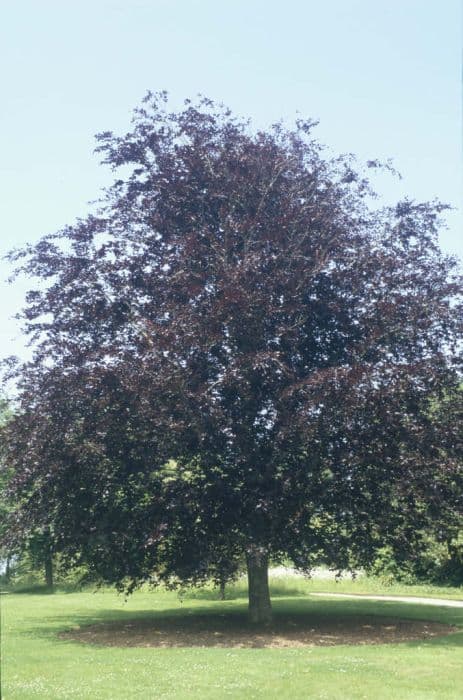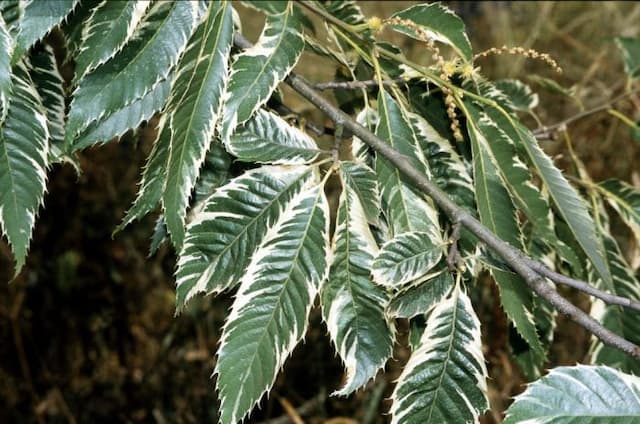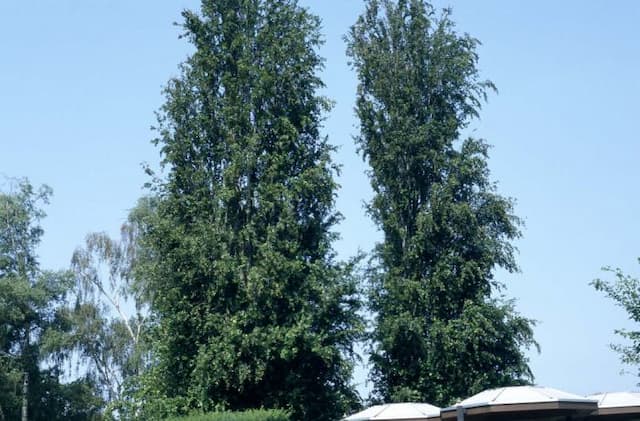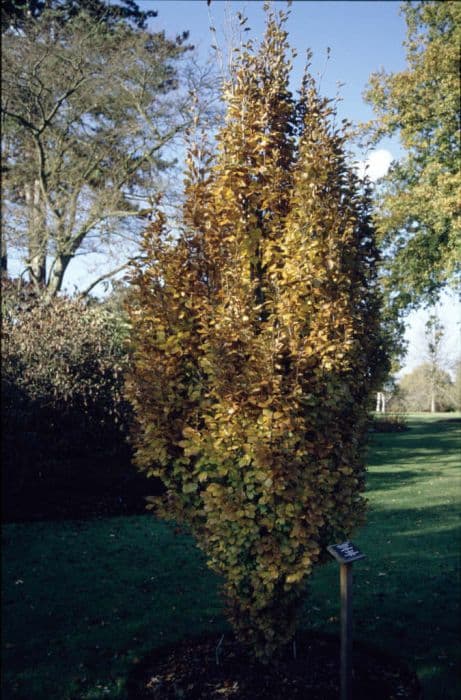European Beech Fagus sylvatica Atropurpurea Group

ABOUT
The European beech with purple leaves, commonly known as the Copper Beech or Purple Beech, is a stunning variety with a striking foliage color. Its leaves are a deep purple, sometimes with a hint of red or copper that creates a rich tapestry of color in the landscape. As the seasons change, so does the leaf color, starting as a vivid purple in spring, maturing to a darker, purplish-black in the summer, and finally turning to a coppery bronze in the fall. The leaves themselves are broad, with a smooth, glossy texture and wavy edges. They are arranged alternately on the branches, forming a dense canopy which can offer considerable shade beneath. The bark of the Purple Beech is smooth and silver-gray, making a pleasing contrast against the darkness of the leaves. The European beech with purple leaves produces inconspicuous flowers in the spring, which give way to small, triangular nuts that are held in spiky cases. These nuts are often sought after by wildlife. This tree has a stately and elegant appearance with a well-branched structure, and its gracefully spreading branches create a rounded outline that adds to its ornamental value.
About this plant
 Names
NamesSynonyms
European Beech, Copper Beech, Purple Beech, Purple-leaf Beech.
Common names
Fagus sylvatica 'Atropurpurea', Fagus sylvatica f. purpurea, Fagus sylvatica var. atropunicea, Fagus sylvatica f. atropurpurea, Fagus sylvatica 'Riversii', Fagus sylvatica 'Cuprea'.
 Toxicity
ToxicityTo humans
The European beech is generally not considered toxic to humans. However, large quantities of the seeds or nuts may cause digestive discomfort or other gastrointestinal symptoms due to the presence of tannins within the seeds.
To pets
The European beech is not commonly listed as a toxic plant to pets such as dogs and cats. Ingesting small quantities of the leaves or seeds is unlikely to cause serious harm, but consumption of large amounts may lead to mild gastrointestinal upset due to tannins.
 Characteristics
CharacteristicsLife cycle
Perennials
Foliage type
Deciduous
Color of leaves
Purple
Height
50 70 [15 21]
Spread
35 50 [10.5 15]
Plant type
Tree
Hardiness zones
4-7
Native area
Europe
Benefits
 General Benefits
General Benefits- Aesthetic Appeal - Provides striking purple foliage, adding visual interest to landscapes.
- Shade Provider - Grows into a large tree that offers considerable shade in gardens and parks.
- Habitat for Wildlife - Offers food and shelter for birds, squirrels, and various insects.
- Carbon Sequestration - Like all trees, it captures carbon dioxide, helping to mitigate climate change.
- Soil Stabilization - Its extensive root system helps to prevent soil erosion.
- Seasonal Interest - Offers year-round interest with changing leaf colors and textures.
- Privacy Screen - Can be used to create privacy barriers in large gardens or estates.
- Windbreak - Acts as a barrier against strong winds, when planted in rows or groups.
- Drought Resistance - Mature specimens can be quite resistant to periods of drought.
- Sound Barrier - Dense foliage and thick branches can help to reduce noise pollution.
 Medical Properties
Medical PropertiesThis plant is not used for medical purposes.
 Air-purifying Qualities
Air-purifying QualitiesThis plant is not specifically known for air purifying qualities.
 Other Uses
Other Uses- The European beech can be used in woodworking for furniture, flooring, and decorative items due to its hard and strong wood.
- Beech wood is a favored material for making musical instruments such as drums and guitar bodies, offering superb acoustics and durability.
- Due to its dense and fine grain, European beech is utilized in the production of plywood and veneers for various construction and design purposes.
- The wood is suitable for making toys and sports equipment, where hardness and resistance to wear are desirable traits.
- Beech mast (the tree's nuts) can be used to feed livestock, particularly pigs, in rural communities.
- Carvers and woodturners appreciate beech for its ease of manipulation, using it to create intricate sculptures and turned objects.
- The European beech's uniform texture makes it useful in the fashioning of tool handles, known for their comfortable grip and durability.
- Due to its ability to bend under steam, European beech is often used in the production of bentwood furniture.
- In fine art, beech wood panels serve as a smooth and stable canvas for painting, providing an alternative to the more traditional linen or cotton canvases.
- The bark of the European beech can be used in the tanning industry as a natural source of tannin for treating leather.
Interesting Facts
 Feng Shui
Feng ShuiThe European Beech is not used in Feng Shui practice.
 Zodiac Sign Compitability
Zodiac Sign CompitabilityThe European Beech is not used in astrology practice.
 Plant Symbolism
Plant Symbolism- Endurance and Longevity: Fagus sylvatica Atropurpurea Group, commonly known as the European beech or simply the beech, is known for its longevity and ability to endure the elements, making it a symbol of stability and resilience over time.
- Knowledge and Wisdom: Since ancient times, beech trees have been associated with written communication and learning, often serving as a symbol for acquiring knowledge and wisdom.
- Patience: The slow growth rate of the beech tree is emblematic of patience and the understanding that meaningful development often requires time.
- Tolerance: The toleration that beech trees have for different soil types and conditions is reflected in its symbolic representation of tolerance, inclusivity, and flexibility in various aspects of life.
- Prosperity: In some traditions, beech wood was used for making writing tablets or other tools, linking it with prosperity through trade and communication.
 Water
WaterThe European beech (Fagus sylvatica 'Atropurpurea'), also known as the Purple Beech or Copper Beech, prefers consistently moist soil but cannot tolerate standing water. Water young trees deeply and regularly, about once a week, providing around 1-2 gallons per inch of trunk diameter at each event, to encourage a strong root system. Mature trees are more drought tolerant and require less frequent watering, you can decrease to biweekly or even less often, especially if there's sufficient rain. During hot or dry spells, increase the frequency to ensure that the soil doesn't dry out completely. It is essential to adjust the watering schedule based on the weather conditions and the soil's moisture level.
 Light
LightThe Purple Beech tree thrives in full sun to partial shade. Planting it in a location that receives at least four to six hours of direct sunlight per day is optimal, though it can tolerate some shade. The ideal spot would be an area with morning sunlight and afternoon shade, particularly in hotter climates to protect the foliage from scorching.
 Temperature
TemperatureThe Purple Beech tree is hardy and adapts well to a wide range of temperatures, growing comfortably in USDA hardiness zones 4 through 7. It can survive winter lows down to -20°F and is tolerant of summer highs typical of these zones. The ideal temperature range for the Purple Beech would be between 50°F and 75°F, which encourages healthy growth.
 Pruning
PruningPruning the Purple Beech is mainly necessary to maintain its shape and remove any dead or diseased wood. It is best done in late winter or early spring before new growth begins. Pruning can also be done after the leaves have fully developed to correct any structural issues. Established trees typically require minimal pruning, and any major pruning should be done every few years to maintain a strong framework.
 Cleaning
CleaningNot needed
 Soil
SoilThe European Beech (Fagus sylvatica 'Atropunicea') thrives best in well-draining, fertile soil with a slight acidity to neutral pH, ideally ranging from 5.5 to 7.0. A soil mix containing loam, well-rotted compost, and leaf mold is ideal to provide a balanced structure and nutrients.
 Repotting
RepottingEuropean Beech trees, when grown in containers, should be repotted every 2 to 5 years depending on growth rate and container size. Over time, as the tree matures, repotting can be done less frequently but the soil should be replenished.
 Humidity & Misting
Humidity & MistingEuropean Beech trees prefer moderate ambient humidity but are adaptable to a range of conditions and do not require specific humidity levels as long as soil moisture is appropriately managed.
 Suitable locations
Suitable locationsIndoor
Not suitable for indoor growth due to size.
Outdoor
Plant in well-drained soil, full sun to part shade.
Hardiness zone
4-7 USDA
 Life cycle
Life cycleFagus sylvatica Atropurpurea Group, commonly known as the Copper Beech or Purple Beech, starts its lifecycle with the germination of seeds, typically requiring cold stratification to break dormancy. Seedlings emerge in spring, often relying on partial shade for early development, and gradually establish a deep root system. Following the juvenile phase, the plant enters a long vegetative stage characterized by the development of its distinctive purple leaves and smooth, silvery bark as it matures into a large tree. As an adult, the Copper Beech produces small, inconspicuous flowers in spring - male flowers in globe-shaped heads and female flowers in pairs, leading to the development of beech nuts (mast) enclosed in a prickly husk by autumn. Trees are typically capable of reproduction after 30-40 years, and can live for several centuries, undergoing cycles of flowering and seed production annually. The mature tree, eventually, enters a phase of senescence leading to reduced vitality and, ultimately, death.
 Propogation
PropogationPropogation time
Late winter-early spring
The European beech, particularly the Fagus sylvatica Atropurpurea Group, also known as the Purple Beech or Copper Beech, is most commonly propagated by seed. Seed propagation takes advantage of the tree's natural reproductive cycle and is typically performed in the autumn season immediately after seed maturity. To propagate by seed, one should collect the ripe beechnuts and plant them in the ground at a depth of about 1-2 inches (2.5-5 cm). It is important to select a well-drained soil and a location that allows for enough space for the mature tree. Seeds require a cold stratification period to break dormancy, which involves exposure to cold, moist conditions for a duration that may range from a few weeks up to a few months before germination occurs in the spring.









